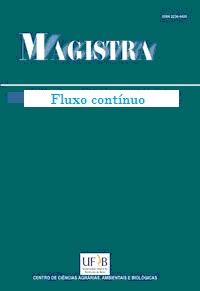Physical, chemical and industrial quality in upland rice genotype
Resumo
Abstract: For the recomendation of the new rice cultivars, it is necessary that these have the physical, chemical and industrial standard of quality required by the market. The lines must have long thin classification, intermediate amylose content and gelatinization temperature, and high percentage of whole grains. This study aimed to evaluate the quality of grains in the elite lines of the UFLA Rice Breeding Program. The experiments were carried out in the experimental area of the Department of Agriculture, UFLA/MG in the 2013/14 and 2014/15 seasons, and in the Epamig experimental farm, Sertãozinho experimental field, in Patos de Minas/MG, in the 2013/15 season. After harvest evaluated the traits: yield (kg.ha-1), percentage of whole grains, length/thickness ratio (mm), chalky grains percentage, amylose content (%) and gelatinization temperature (notes) were processed and determined. For most traits evaluated, the genotypes x environments interaction was significant, indicating differences in the behavior of lines in different environments. The lines showed thin long grain classification, intermediate amylose content and medium to low gelatinization temperature. CMG 2097 genotype is outstanding, which has a high percentage of whole grains, high yield potential and ideal phenotypic traits for high quality of grain.
Keywords: Oryza sativa L, Grain quality, Baking quality.
Downloads
Referências
Bergman, C. J. (2019). Rice end-use quality analysis. In: Bao J. Rice: Chemistry and Technology AACCI (Cap 9, pp. 273-337). Las Vegas: University of Nevada Las Vegas. DOI: https://doi.org/10.1016/B978-0-12-811508-4.00009-5
Brasil. Ministério da Agricultura. Secretaria Nacional de Abastecimento. (2012). Normas de identidade, qualidade, embalagem e apresentação do arroz (v.8, n.20, pp. 1-25). Brasília, DF: Secretaria Nacional de Abastecimento.
Breseghello, F. (2011). Results of 25 years of upland rice breeding in Brazil. Crop Science, Madison, 51 (3), 914-923.DOI: https://doi.org/10.2135/cropsci2010.06.0325
Ferreira, D.F. (2019). Sisvar: A computer analysis system to fixed effects split plot type designs. Revista Brasileira de Biometria, Lavras, 37 (4), 529-535. DOI: https://doi.org/10.28951/rbb.v37i4.450.
Foundation for Statical Computing (2019). R core Team: A language and evironmental for statical computing. Vienna, Austria: Foundation for Statical Computing Recuperado de URL https://www.R-project.org/.
Garcia, N.F.S. et al.(2015). Rendimento e qualidade de grãos de arroz de terras altas em função de doses e modos de inoculação com Azospirillum brasilense. Enciclopédia biosfera, 11 (21). Recuperado de https://conhecer.org.br/ojs/index.php/biosfera/article/view/1892
Grigg, B.C., & Siebenmorgen, T.J. (2015). Impacts of kernel thickness and associated physical properties on milling yields of long-grain rice. Applied Engineering in Agriculture, Michigan, 31 (3), 505-511. DOI 10.13031/aea.31.10867
Little, R.R., et al. (1958). Differential effect of dilute alkali on 25 varieties of milled white rice. Saint Paul, Cereal Chemistry Journal, 35, 111-126.
Martinez, C.Y. et al. (1989). Evaluación de la calidad culinária y molinera del arroz. Cali, CO: Centro Internacional de Agricultura Tropical.
Pagnan, M.F., et al (2015) Características sensoriais, físicas e químicas e aceitação de arroz irrigado ou de terras altas. Pesquisa Agropecuária Brasileira, Brasília, 50 (10), 979-988.
Paiva, F.F., et al. (2015). Polishing and parboiling effect on the nutritional and technological properties of pigmented rice. Food Chemistry, London, 191, 105-112. DOI: 10.1016/j.foodchem.2015.02.047
Pierobon, F., et al. (2016). Occurrence of grain chalkiness in upland rice genotypes grown with and without irrigation. International Journal of Current Research, 8 (2), 26480-26483.
Ramalho, M.A.P., et al.(2012). Aplicações da genética quantitativa no melhoramento de plantas autógamas (522p). Lavras: UFLA.
Shehab, G.G., Ahmed, O.K., & El-BeltagiL, H.S. (2010). Effects of Various Chemical Agents for Alleviation of Drought Stress in Rice Plants (Oryza sativa L.). Notulae Botanicae Horti Agrobotanici Cluj-Napoca, Cairo, 38 (1) , 139-148. DOI: https://doi.org/10.15835/nbha3813627
Soares, P.C., et al. (2004). Cultivares de arroz de terras altas e de várzeas recomendadas para Minas Gerais. Informe agropecuário, 25 (222), 25 34.
Utumi, M.M. (Ed.) (2008). Sistemas de produção de arroz de terras altas. (Sistema de produção, n. 31). Porto Velho: Embrapa Rondônia
Downloads
Publicado
Como Citar
Edição
Seção
Licença
Autores que publicam nesta revista concordam com os seguintes termos:- Autores mantém os direitos autorais e concedem à revista o direito de primeira publicação, com o trabalho simultaneamente licenciado sob a Licença Creative Commons Attribution que permite o compartilhamento do trabalho com reconhecimento da autoria e publicação inicial nesta revista.
- Autores têm autorização para assumir contratos adicionais separadamente, para distribuição não-exclusiva da versão do trabalho publicada nesta revista (ex.: publicar em repositório institucional ou como capítulo de livro), com reconhecimento de autoria e publicação inicial nesta revista.








